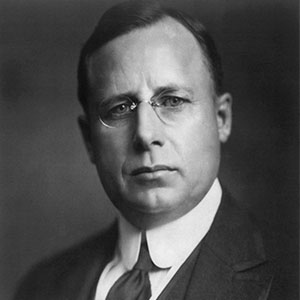After serving as a successful Ohio businessman and politician, James Cox lost the 1920 presidential election by a landslide. While it marked the end of Cox’s political career, it created national name recognition for his running mate, Franklin D. Roosevelt.
Early Life and Publishing Career
James Cox was born in Jacksonburg, Ohio, in 1870. In 1886, he got his start in journalism as an apprentice with the Middletown Weekly Signal. In 1892, he got a job at the Cincinnati Enquirer as a copy reader and then a reporter. In 1894, Cox became an assistant to Middletown businessman Paul J. Sorg. Cox followed Sorg to Washington, D.C. when he was elected to U.S. Congress. Sorg later helped Cox to buy the struggling Dayton Evening News, which Cox was able to turn around into a successful newspaper. He later acquired the Springfield Press-Republic, which he renamed the Springfield Daily News.
Entry into Politics
After using his newspapers to shine a light on political corruption, Cox first ran for public office in 1908. He was elected to the U.S. House of Representatives and served from 1909 to 1913.
Cox subsequently served three terms as Governor of Ohio. After winning the 1912 election, he served from 1913 to 1915. While Cox lost his reelection bid in 1914, he returned to office in 1916 and went on to serve from 1917 to 1921. During his tenure as governor, Cox pursued a number of progressive reforms. He established a no-fault workers’ compensation system and reformed the state’s prison and education systems.
Presidential Election of 1920
When it came time to nominate their candidates for the 1920 presidential election, neither the Republican nor Democratic party had a clear frontrunner. The Democrats ultimately selected Cox as their dark-horse candidate. To balance the ticket, they chose FDR as his running mate. The Republicans also selected two relatively unknown candidates, Warren G. Harding and Calvin Coolidge.
Cox and Roosevelt campaigned all over the country, with FDR often making seven speeches in one day and Cox visiting 36 states. In the end, the Republican’s message of a “return to normalcy” resonated with voters. Harding won more than 60 percent of the popular vote and carried Cox’s home state of Ohio. “An irresistible combination of reasons, unreasons and opponents bore him down,” The New York Times said of Cox’s landslide defeat. “He did all that could be done and more than most men could have done.”
After losing the election, Cox retired from public service and returned to his publishing company. Today, Cox Enterprises, Inc. is a billion-dollar company that includes 24 newspapers, 14 television stations, and 57 radio stations.
Cox and Roosevelt remained friends. FDR, of course, went on to serve as Governor of New York and President of the United States. Many credit the contacts he made while campaigning in 1920 with bolstering his later political success.









